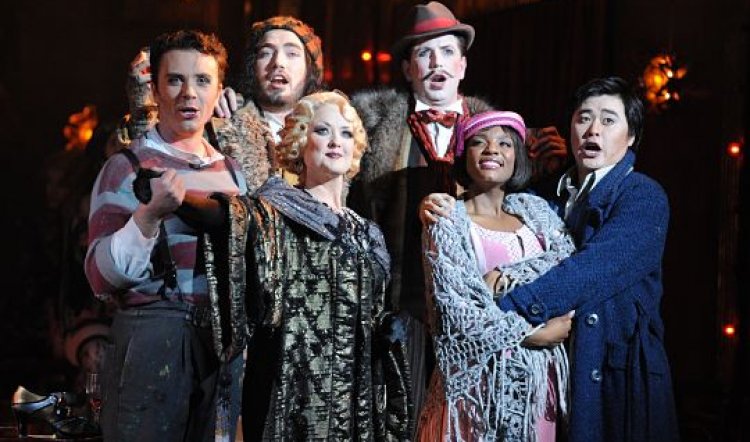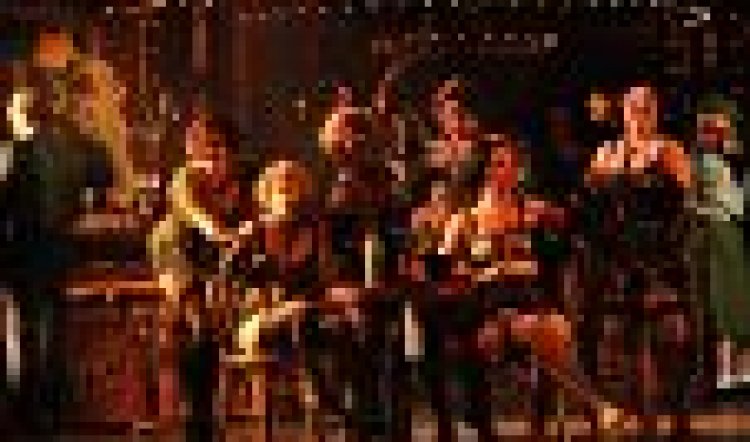
La boheme
La bohème, Opera Australia at the Sydney Opera House, July 12-October 24, 2011. Photos by Branco Gaica
It's 1930s Berlin and the bohemians are living the high life of art for art's sake and other dubious pleasures. It's not exactly arrested development, but Rodolfo, Marcello and their pals carouse with all the carefree confidence of young men who know they will one day come into inheritances; or that Daddy will stump up the cash if they exceed their allowances. Failing that, the would-be artists and poets know the minute they say, "oops - you were right, I'll join the family business after all," they'l be airlifted back to creature comforts and that'll be the end of freezing, walk-up studios and picturesque poverty. But it's not the same for their girlfriends.
For starters, none are upper class nor even of the middle - those young women couldn't dream of such dangerous freedom, even in the early decades of the 20th century - and none are merely playing at being poor. Mimi is a seamstress; Musetta is, of necessity, a gold-digger - nobody is about to rescue them from society's lower reaches, least of all their young gentlemen. It's just not going to happen (which is where consumption (TB) comes in so handy: a tragic end for Mimi absolves all of responsibility and Rodolfo of having to make cruel decisions). And that, more or less, is the plot of the Puccini favourite and masterpiece, La bohème.
Director Gale Edwards has accomplished something special in setting down the young bohemians in the dying days of the Weimar Republic: first, she takes on and faces down the hitherto-overwhelming visual memory of the Luhrmann-Martin production of 1990. And that's no mean feat: there have been two other bohèmes for OA since that one - can you recall either? Second, Weimar's politics and style are a seamless match for Puccini's world of the Parisian demi monde, from Cafè Momus-Spiegeltent and that brand of decadence to a marching band in gaudy uniforms of Bavarian frogging and deceptively Ruritanian silliness. This fleeting moment - as the musicians strut and oompah - signals to an audience (equipped with history's hindsight) that Hitler is approaching fast amid the financial and social ruin that underlies the bright lights, beer and bosoms of Berlin's louche nightlife.
Fortuitously, an exhibition of the best German art of the time (sadly none by Marcello or the idly dabbling Rodolfo!) is on display at the Art Gallery of NSW (August 6-November 6, 2011) in The Mad Square - Modernity in German Art 1910-37. Taking in both La bohème and this show will give an unprecedented experience and insight into this pivotal period in European culture.
The Edwards bohème is a masterpiece in itself, however. The creative team is second to none, with Brian Thomson devising a three-in-one setting of studio-Momus/Spiegeltent-city tollgate that not only looks terrific but also works with applause-worthy simplicity. John Rayment's lighting design does tawdry nitery with wit and empathy and also provides the different spaces for the performers within the otherwise simple settings. Julie Lynch excels herself with the costumes, obviously having taken full advantage of OA's costume makers. The lavish range of outfits, from Musetta's already famous Swarovski evening gown and the gaudy finery of the nite club gals, to the everyday stylish tat of the bohemians - dinky pullovers and overlarge winter coats (Rodolfo and Marcello), dandyish Isherwood gear for Schaunard and so on. The production is a feast for the eyes.

It's also a feast for the ears and for those who appreciate a well-acted as well as well-sung opera. Although a little wayward in the opening moments of Rodolfo's first passionate aria as he meets and falls in love with Mimi, Ji-Min Park quickly settled into a heart-thumpingly attractive performance: no wonder Takesha Meshè Kizart falls for him. And he for her: the American soprano thrilled Sydney audiences last year as a fairly last minute but wondrously sung and acted Tosca and she demonstrates the depth of her talent as the fragile, tragic and luminously, spiritually beautiful Mimi. The other half of the main quartet is equally strong. A pert and sassy Musetta is yet another standout performance from Taryn Fiebig, vocally strong and intelligently acted, she makes a three-dimensional woman out of one that's often reduced to a 'toonish Betty Boop.
For this particularly long season, there are three singers engaged to play Rodolfo's best mate and Musetta's lover, Marcello. On opening night in Sydney a flu-stricken Josè Carbó was replaced by Andrew Jones (who'll be taking over from August 12-September 17 anyway) and he's a delight, able to sing up to Fiebig and convince that he is a young man on the make. The bohemian gang is completed by David Parkin as the hippy-layabout philosopher Colline and Shane Lowrencev as the foppish muso, Schaunard. Both are deserved favourites in the OA company and are among its most valuable vocal and histrionic assets.
The rest of the company and chorus and orchestra are invited by conductor Shao-Chia Lü to stretch themselves and enjoy some of Puccini's lushest and best known music; the response is wholehearted and a reminder, if one is needed, that OA has a very fine orchestra and chorus and welcome depth in its ensemble of older, character singers (John Bolton Wood as the landlord Benoit and Adrian Tamburini as Musetta's sugar daddy Alcindoro, for instance).
All told, this new production of La bohème is a triumph for OA and a particular one for Gale Edwards. Her eye for and instinctive insistence on the fine details of a performance go much further and deeper than the principals. The result is a dramatic and emotional journey that is at times overwhelming. I ended the evening sobbing but had a truly wonderful time. Go figure.



